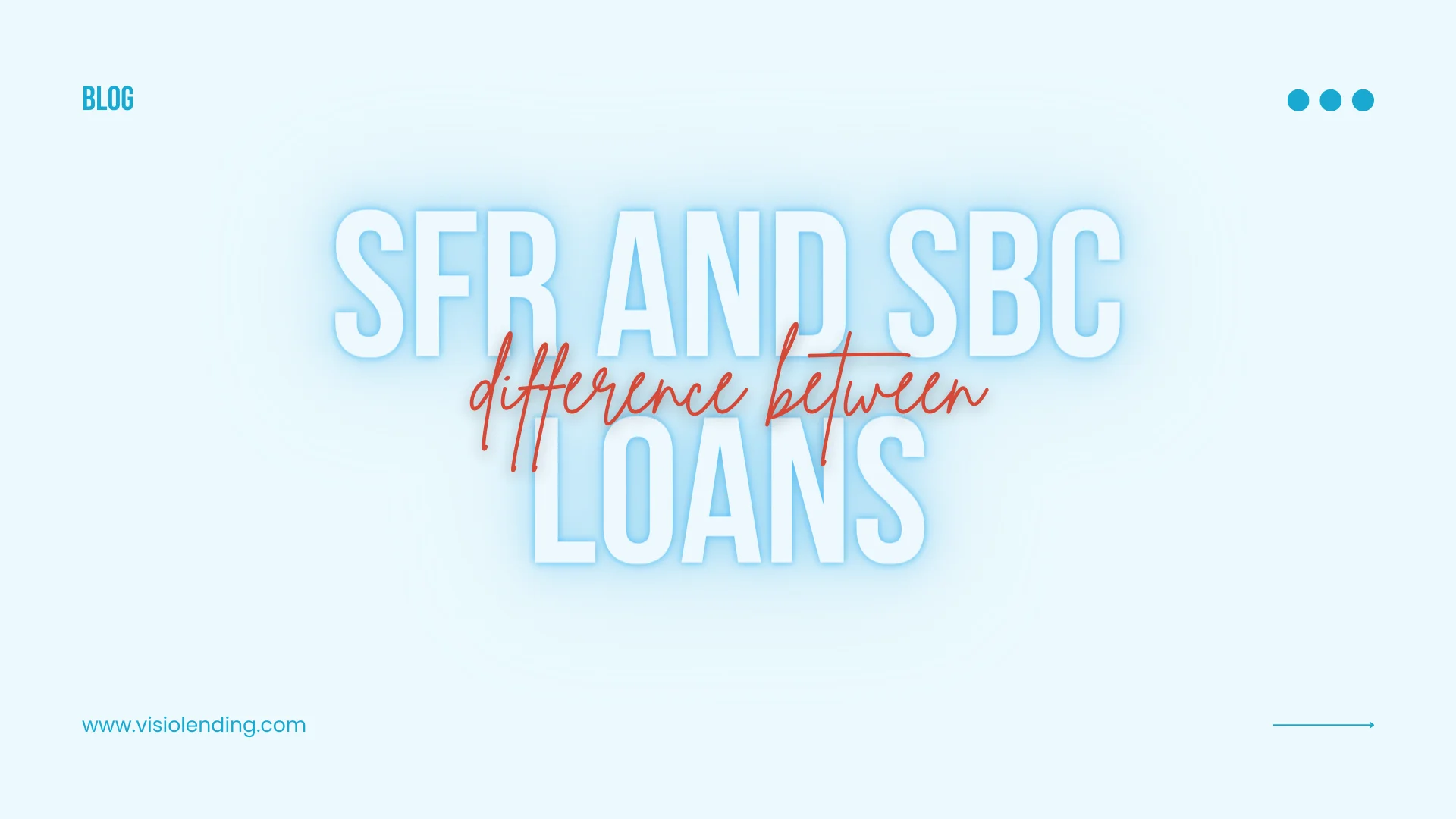First off, let’s start by defining the terms SFR and SBC so we are all on the same page:
- SFR (Single-Family Residential):
SFR or single family residential is a residential property that has up to 4 units. - SBC (Small Balance Commercial):
SBC or small balance commercial is a commercial property. The property type itself may be multifamily (5+ units), retail, mixed-use, office, warehouse, light industrial, flex space (warehouse and office), or self-storage.
SFR loans can be broken into consumer and investor loans, which we’ll cover more later. On the surface, there is not much difference between a typical investor loan secured by an SFR (single family residence that is non-owner occupied) and an investor loan secured by an SBC (small balance commercial) asset. Both types of loans are secured by a mortgage or deed of trust (depending on the location of the property) and the borrower is usually a single asset limited liability company that owns the subject property.
So, in this blog we will explore the kinds of SFR loans as well as the similarities and differences that are typical of a private lender underwriting a standard SFR rental loan and a standard SBC loan (note each lender has its own underwriting guidelines which may differ from the information contained herein).
Types of SFR Loans
As we mentioned, SFR loans can be categorized into consumer loans and business purpose loans. They can also be categorized into private label versus government-sponsored loans. Let’s take a closer look at each category of loans available for single-family homes.
Government-Sponsored Consumer Purpose SFR Loans
These loans are less expensive than other loans and meet the criteria established by Fannie Mae and Freddie Mac. These loans are also primary home loans often targeted at first-time home buyers. Here are some special loan programs under this category:
- FHA Loans: These loans are designed to help low-income borrowers obtain a primary residence and have low down payment and credit score requirements.
- VA Loans: These loans are designed to help veterans and active duty service members obtain a primary residence. They are backed by the U.S. Department of Veterans Affairs.
- USDA Loans: These loans are designed to promote rural development and are backed by the U.S. Department of Agriculture.
Government-Sponsored Business Purpose Loans
This bucket of loans is less expensive than private loans, yet more restrictive. They can be hard to qualify for, especially for self-employed investors with multiple rental properties.
- Conforming Investment Property Loans: Traditional lenders offer investment property loans, however they come with strict qualifications such as high reserves and low Debt-to-Income Ratio.
Private Label Consumer Purpose Loans
These loans are designed for consumers who do not meet the criteria set forth by Fannie and Freddie. Here are some examples:
- Jumbo Loans: Jumbo loans are primary home loans for borrowers with good credit whose primary residence exceeds the limit set by Fannie and Freddie, which is $726,200 as of 2023.
- Non-QM Loans: While Non-QM loans can be used to buy rental properties, there are also some consumer-purpose ones including bank statement loans and foreign national loans.
Private Label Business Purpose Loans
This group of loans tends to be the most expensive and have the highest down payment requirements, yet also be the most flexible.
- Investor Renovation Loans: Also known as flip loans, these are short-term loans designed for investors to purchase and rehab single-family homes.
- Investor Rental Loans: These loans are designed to help investors build portfolios of single family rental properties. While they require a good credit score and large down payment, they do not evaluate personal income.
A Closer Look at SFR Rental Property Loans
For the rest of this blog, we are going to focus on single-family residential rental loans and then later compare them to SBC Loans. There are essentially three financing options for single-family rental loans: through a government agency, through local banks, or through private lenders. Let’s take a quick look at each loan type.
Government-Sponsored Consumer Purpose SFR Loans: These loans have the lowest interest rates, yet the most stringent requirements. Real estate investors with multiple investment properties often do not qualify for this loan type.
Local Banks
: Many real estate investors have success with their local banks and credit unions and are able to obtain favorable interest rates. However, banks and credit unions do not have loan terms that accommodate investors. For instance, they often have balloon payments.
Private Loans
: A private lender such as Visio Lending has loan terms designed for real estate investors. Some potential advantages of working with a private lender include that they originate based on rental income rather than personal income. You might get a higher interest rate and have a prepayment penalty, however professional real estate investors are able to make the loan terms work with their investment strategies.
Comparing Single Family Rental Loans to SBC Loans
Although single-family rental loans are business purpose loans, they are still for residential real estate. Let’s take a closer look at single-family rental loans compared to SBC loans in terms of underwriting, appraisals, and documentation.
Underwriting Processes for Single Family Rental Properties Compared to Small Balance Commercial Properties
The underwriting standards of the borrower and guarantor will be very similar with SBC and SFR loans. The greatest differentiators are between banks and private mortgage companies. Private mortgage companies tend to be more asset based when underwriting a loan. This differs greatly with a bank, as a bank typically is underwriting a loan and looking for three sources of repayment, which are the cash flows from the property, global excess cash flows from the borrower and/or guarantor and finally the liquidation of the collateral in the event of default. Private lenders, for both SFR loans and SBC loans, rely heavily on the property’s monthly income to cover the mortgage payments and the value of the subject collateral in relationship to the loan amount (loan to value or LTV) in the event of a default. And while a private lender will review a borrower/guarantor’s credit report (and fraud reports) many do not require submission of tax returns, nor do they require a global operating expenses vs. income analysis with supporting documentation.
A Look at Underwriting the Collateral for SFR vs. SBC Loans
Underwriting a cash flowing single-family rental or SBC property are similar in that the underwriter is reviewing the rental stream. In both cases you have a lease or leases identifying the tenant(s) and the agreed upon rental payment in exchange for use of the subject property or a portion thereof. Cash flow from either a single-family rental or an SBC property will be the primary factor in determining the value of the property along with the property’s ability to cover loan payments.
In an SBC asset, you are more likely to see multiple leases for a single asset (i.e. a multifamily building, a small retail strip center, etc.). Most assets that fall under the general definition of Small Balance Commercial will have relatively simple operating cash flows much like an SFR asset. So, the approach is very similar to SFR underwriting, except you are now looking at several leases that comprise the cash flow and that need to be reviewed and underwritten. In addition, the quality of the tenant in an SBC asset is under much more scrutiny because it typically is much easier to replace a tenant in an SFR property than a tenant in an SBC property. Under most SBC leases, you are not going to be able to underwrite the tenant’s financials, so an underwriter will be reviewing the length of time the tenant has been in place, the remaining term of the lease, the lease economics and the tenant’s payment history. This is critical when the space has a specific use, such as a restaurant, where conversion to another commercial use may not be financially viable. Contrast this with a standard 50’ x 100’ retail bay with a restroom and back office. This type of space provides flexibility for a potential tenant, who may want to use the space for an insurance or realty office (assuming the use is allowed under the local zoning laws) as opposed to the retail shop. The flexibility of the space along with local market conditions (i.e. vacancies) are critical to the review of the property to determine the likelihood of finding a replacement tenant for a vacant bay.
In an single-family rental asset, the layout of the house will be critical in determining how attractive the home will be to a new renter. For example, if the one-bedroom home is in a highly rated school district, this property maybe harder to rent, as it is not attractive to families with school age kids due to the lack of additional bedrooms. This along with the local area vacancy rate will be critical in underwriting a loan.
For both an single-family rental and SBC asset demonstrating that the rental income will continue to be on-going and attractive to other tenants in the event of a vacancy is critical to the underwriting of the asset.
What to Expect in Appraisal Reports for Single Family Rentals and SBC Properties
The primary difference between the two asset classes is the type of appraisals that are required.
For single-family rentals, private lenders will typically order an appraisal based on a FNMA (Fannie Mae) Form 1004. This type of appraisal is a standard form and uses three methods to determine the asset value. These three methods are Sales Comparison Approach, Income Approach and Cost Approach (note the last two methods are not required by FNMA for conventional residential financing). The indicated values of the three methodologies are then reconciled by the appraiser to determine the appraiser’s opinion of market value. An appraiser will require the borrower provide the asset address and purchase contract (if applicable). A single-family rentals report is typically a 7 to 10-page form-based appraisal compared to a SBC appraisal which is a narrative report that typically is upwards of a hundred pages. The SFR report is usually around $350 to $500 with a 7 to 10-day turnaround time.
For an SBC asset, the lender will order an Appraisal Report that must comply with both USPAP (Uniform Standards of Professional Appraisal Practice) and FIRREA (Financial Institutions Reform, Recovery, and Enforcement Act of 1989) requirements. The Appraisal Report will contain the above mentioned three methodologies to determine the indicated value of each method with a final reconciled market value as determined by the appraiser. To complete the report, the borrower will typically provide the asset address, purchase contract (if applicable), leases and other documentation that support both income and expenses of the property. The Appraisal Report takes the form a narrative appraisal where the format is determined by the appraiser as long as all the requirements of both USPAP and FIRREA are included. An SBC appraisal report will typically range from $2,500 to $5,000 with a 2 to 4-week turnaround time.
As you can see, the methodologies essentially the same, with the required borrower supplied documentation, report format, cost and completion time being the primary differences.
Small Balance Commercial Properties Also Require Environmental Reports
Typically, an environmental report is not required for a single-family rental property, so you can see why many residential mortgage brokers may be put off by SBC loan requirements for an environmental report. But the fear is unfounded as we have moved away from the old requirements of a lengthy Phase I Environmental Report and, if needed, a Phase II Environmental Report. Private lenders are now ordering concise environmental reports that are form based and provide a score from 1 to 5 to determine the level of environmental risk associated with an asset. These reports are relatively inexpensive (+/- $200) and can be completed in a matter of days. Of course, these basic reports are fine for low risk assets, such as multifamily, retail and office. Other property types, which are typically excluded by SBC lenders, such as gas stations, dry cleaning plants and heavy industrial properties will require the completion of a Phase I Environmental Report and most likely a Phase II Environmental Report.
Loan Documentation is Simpler for Single-Family Rentals
Basic loan docs (note, mortgage or deed of trust, personal guaranty, assignment of rents and leases, etc.) are going to be very similar regardless if the loan is secured by single-family rental properties or small balance commercial properties. property. Both sets of loan documentation will conform to all lending laws to perfect their interest (lien) in the subject property. Since the SFR loan, under our assumptions, is an investor loan and not owner-occupied, you will not necessarily see all the consumer disclosures as required by law.
The difference in loan docs between a single-family rental (SFR) property and SBC asset start to emerge as the complexity of the asset increases. While the loan documentation package will be very similar between an SFR and a small multifamily property, that changes drastically with assets, such as, large retail centers with credit tenants, large office buildings and other specialty properties (i.e. hotels, warehouses, gas stations, etc.). Additional documentation for these type assets may include tenant estoppels, non-disturbance agreements, complex environmental indemnity agreements, lock box agreements, and so forth. These types of complex documents are reserved for properties that are not typically seen in the SBC world.
Summary
An SFR loan and SBC loan are very similar in that one must understand the cash flow generated by the subject property. Hopefully, my goal of demystifying small balance commercial lending will inspire residential mortgage brokers to add SBC loans to their product offerings. I would encourage residential mortgage brokers to survey their clients and find out which of them owns or is looking to purchase small multifamily buildings (5 – 50 units) or mixed-use properties (with residential and retail units in the same property) as a entry point into SBC lending world. We are finding that many SFR investors own or are looking to own these type assets.
Rental property loans are also a good revenue for residential mortgage brokers looking to add more financing options to their portfolios.
Grow Your Single-Family Rental Portfolio with Visio Lending
Visio Lending is the nation’s leader in rental loans with over $2.3 billion financed buy-and hold investment properties. Our flagship Rental360 rental property loan is underwritten based on investment property income. Our loan terms are tailored to investors with no tax return requirements or personal income verification. Contact us today to start your loan.






